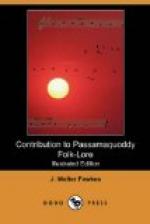The Indian dances held in honor of the chief (governor) and other officers continued for several days. On the first night the newly elected chief sang a song complimentary to the food, thanking the tribe, greeting the past governor, etc. Noel Josephs, at the last celebration, sang this song by proxy, as the newly elected chief could not sing. When sung by proxy, the song is called by another name than when sung by the person elected. This song is preserved on one of the cylinders.
TRADE DANCE.
I have been told that there is an old custom among the Micmacs, still remembered by many now alive, which is probably a remnant of a ceremony with which was connected an old dance. To this custom is given the name of the “Trade Dance,” for reasons which will appear. The account of the custom was given by Peter Selmore, who witnessed it not many years ago. It is said to be more common among the Micmacs than among the Passamaquoddies.
The participants, one or more in number, go to the wigwam of another person, and when near the entrance sing a song. The leader then enters, and, dancing about, sings at the same time a continuation of the song he sang at the door of the hut. He then points out some object in the room which he wants to buy, and offers a price for it. The owner is obliged to sell the object pointed out, or to barter something of equal value. The narrator remembers that the dress of the participants was similar to that of the Indians of olden times. He remembers, in the case of women, that they wore the variegated, pointed cap covered with beads, the loose robe, and leggings. The face of the participant was painted, or daubed black with paint or powder.
This song is recorded on cylinder 17.
The singer told me, and I can well believe it, that the song is very ancient. I have little doubt that in this ceremony we have a survival of dances of the olden times, when they assumed a significance now either wholly lost or greatly modified.
It is not without probability that the songs sung as ancient songs may have modern strains in them, but as a general thing I think we can say that they are authentic. I do not think I draw on my imagination when I say that one can detect a general character in them which recalls that of Western Indians. In order to experiment on this, I submitted the records to a person who had heard the songs of the Plain Indians, and who did not know whether the song which she heard from the phonograph was to be Indian or English. She immediately told me correctly in all cases which was the Indian, although she had never before heard the Passamaquoddy songs.




